Internet Explorer 8
Windows Internet Explorer 8 (IE8) is a web browser for Windows. It was released by Microsoft on March 19, 2009, as the eighth version of Internet Explorer and the successor to Internet Explorer 7. It was the default browser in Windows 7 (later default was Internet Explorer 11) and Windows Server 2008 R2[3] and can replace previous versions of Internet Explorer on Windows XP, Windows Server 2003, Windows Vista and Windows Server 2008 but unlike version 7, this version does not support Windows Server 2003 SP1 or an earlier version.
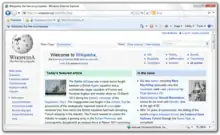 Internet Explorer 8 in Windows 7 | |
| Developer(s) | Microsoft |
|---|---|
| Initial release | March 19, 2009 |
| Stable release | Service Pack 1 (8.00.7601.17514)
/ February 22, 2011 |
| Engine | MSHTML 4.0 |
| Operating system |
|
| Platform | c.f. § platform support |
| Included with | Windows 7 and Windows Server 2008 R2[2] |
| Predecessor | Internet Explorer 7 (2006) |
| Successor | Internet Explorer 9 (2011) |
| Type | Web browser Aggregator FTP client |
| License | Proprietary, requires Windows license |
| Website | technet |
Internet Explorer 8 is the first version of IE to pass the Acid2 test, and the last of the major browsers to do so (In the later Acid3 Test, it only scores 24/100.). Additionally, it introduced a compatibility mode to optionally emulate older versions' rendering behaviour, and colour-coded tab groups where links opened in new tabs share the colour of which they originated from.[4] According to Microsoft, security, ease of use, and improvements in RSS, CSS, and Ajax support were its priorities for IE8.[5][6]
Internet Explorer 8 requires Windows XP SP2—3, Windows XP x64 Edition SP2, Windows Server 2003 SP2 or Windows Vista at the minimum. It is the last version of Internet Explorer to support Windows XP service packs 2—3, Windows XP x64 Edition, SP2, Windows Server 2003 SP2, the x64 versions of Windows Server 2003, Windows Vista RTM—SP1, and Windows Server 2008 RTM; as the following version, Internet Explorer 9, only supports Windows Vista SP2 or later and Windows Server 2008 SP2 or later.[7][8] Support for Internet Explorer 8 is bound to the lifecycle of the Windows version it is installed on as it is considered an OS component, thus it is unsupported on Windows XP due to the end of extended support on April 8, 2014.[9][10] Support for IE8 on most supported Windows versions ended on January 12, 2016, when Microsoft began requiring customers to use the latest version of Internet Explorer available for each Windows version. For versions of Windows in which IE8 was the final version of Internet Explorer available, support ended alongside the end of support for that version of Windows. On April 9, 2019, Microsoft released the final IE8 update for Windows Embedded POSReady 2009, the last supported version of Windows based on Windows XP, marking the end of IE8 support on all platforms.[11]
History
IE8 development started in or before March 2006.[12] In February 2008, Microsoft sent out private invitations for IE8 Beta 1,[13] and on March 5, 2008, released Beta 1 to the general public,[14] although with a focus on web developers.[15] The release launched with a Windows Internet Explorer 8 Readiness Toolkit website promoting IE8 white papers, related software tools, and new features in addition to download links to the Beta.[14][16] Microsoft Developer Network (MSDN) added new sections detailing new IE8 technology.[14][17] Major press focused on a controversy about Version Targeting, and two new features then called WebSlice and Activities. The readiness toolkit was promoted as something "developers can exploit to make Internet Explorer 8 'light up'."[14]
On August 27, 2008, Microsoft made IE8 Beta 2 generally available.[18] PC World noted various Beta 2 features such as InPrivate mode, tab isolation and color-coding, and improved standards and compatibility compared to Internet Explorer 7.[19] Two name changes included Activities to Accelerators, and the IE7 Phishing filter renamed Safety Filter in the first Beta to SmartScreen, both accompanied by incremental technical changes as well.[19] By August 2008, the new feature called InPrivate had taken the spotlight.[19]
The first non-beta version was released on March 19, 2009.
On January 5, 2009, a tool was provided by Microsoft to block the automatic install of Internet Explorer 8 via Windows Update.
As of May 20, 2009, Windows XPe (Embedded) was not a supported platform for Internet Explorer 8. There have been no announcements of planned support.
On May 27, 2010, Microsoft released Internet Explorer 8 optimized for Bing and MSN. The file name is BOIE8_ENUS_XP.exe.
Release history
| Version | Release Date | Windows XP / Windows Server 2003 |
Windows Vista / Windows Server 2008 |
Windows 7 / Windows Server 2008 R2 |
Languages | |
|---|---|---|---|---|---|---|
| Name | Number | |||||
| Beta 1[14] | 8.0.6001.17184 | March 5, 2008 | Yes | Yes | No | 3[20] |
| Beta 2[18] | 8.0.6001.18241 | August 27, 2008 | Yes | Yes | Yes | 25[21] |
| Partner Build (Pre RC)[22] | 8.0.6001.18343 | December 10, 2008 | Yes | Yes | Yes | 1 |
| Release Candidate[23] | 8.0.6001.18372 | January 26, 2009 | Yes | Yes | Yes | 25[23] |
| Final Release[24] | 8.0.6001.18702 | March 19, 2009 | Yes | Yes | Included | 25–63* |
| Service Pack 1 | 8.0.7601.17514 | February 9, 2011 | No | No | Included | 25–63* |
Language support
Language support (localization) was not complete on release. IE8 was released with 25 languages.[24] This grew up to 63 for Vista 32-bit in June 2009.[26] Support for additional languages can come pre-installed based on the OS, or downloaded and installed via Multilingual User Interface (MUI) packages.[25]
Platform support
Internet Explorer 8 supports Windows XP (service packs 2—3), Windows XP x64 Edition (SP2), Windows Server 2003 (SP2), Windows Vista, Windows Server 2008, Windows 7 and Windows Server 2008 R2.
| Operating system | Service pack needed | CPU architecture |
|---|---|---|
| Windows XP | SP2 or later | IA-32[29] |
| Windows XP x64 Edition | SP2 only | x64[30] and Itanium |
| Windows Server 2003 | SP2 only | IA-32[31] and x64[30] |
| Windows Vista | RTM or later | IA-32[32] and x64[33] |
| Windows Server 2008 | RTM or later | IA-32[32] and x64[33] |
| Windows 7 | RTM or later | IA-32[2] and x64[2] |
| Windows Server 2008 R2 | RTM or later | x64[2] and Itanium[2] |
New features
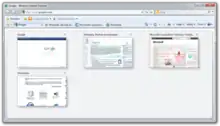
IE8 contains many new features, including WebSlices and Accelerators. At the first glance, the most visible change of the user interface is that the tabs have an inward colour gradient instead of outward.[34][35]
Accelerators
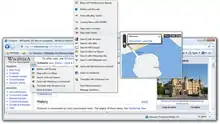
Accelerators are a form of selection-based search which allow a user to invoke an online service from any other page using only the mouse.[36] Actions such as selecting the text or other objects will give users access to the usable Accelerator services (such as blogging with the selected text, or viewing a map of a selected geographical location), which can then be invoked with the selected object. According to Microsoft, Accelerators eliminate the need to copy and paste content between web pages.[34] IE8 specifies an XML-based encoding which allows a web application or web service to be invoked as an Accelerator service. How the service will be invoked and for what categories of content it will show up are specified in the XML file.[37] Similarities have been drawn between Accelerators and the controversial Smart tags feature experimented with in the IE 6 Beta but withdrawn after criticism (though later included in MS Office).[15]
Autocomplete changes
The address bar features domain highlighting for added security so that the top-level domain is shown in black whereas the other parts of the URL are grayed out. Domain highlighting cannot be turned off by users or web sites. Other features of the address bar include support for pasting multi-line URLs and an improved model for inserting the selection caret, and selecting words, or entire URLs in the Address bar. The inline autocomplete feature has been dropped from Internet Explorer 8, leading to criticism by beta users.[38]
Automatic tab-crash recovery
If a website or add-on causes a tab to crash in Internet Explorer 8, only that tab is affected. The browser itself remains stable and other tabs remain unaffected, thereby minimizing any disruption to the browsing experience. If a tab unexpectedly closes or crashes it is automatically reloaded with the same content as before the crash.
Developer tools
For developers, Internet Explorer 8 includes tools that allow debugging HTML, CSS, JavaScript and VBScript within the browser.[39]
Favorites Bar
Another new feature in IE8 is a redesigned Favorites Bar, which can now host content such as Web Slices, web feeds, and documents, in addition to website links.
Inline search within pages
Internet Explorer 8 now has replaced the Find... dialog box with an inline Find toolbar which can be activated by pressing Ctrl+F or from search box drop-down menu but the F3 (or any other kind of a keyboard-driven) NextFind command has gone. Internet Explorer 8 highlights all instances of found words while allowing the user to continue the navigation normally.[40]
InPrivate
A new security mode called InPrivate debuted with IE8, and consists of two main features: InPrivate Browsing and InPrivate Filtering.[19] InPrivate Browsing has been described as a "porn mode" in various news outlets.[41][42][43][44][45][46] A similar feature, first introduced in Safari in 2005,[47] was later implemented in Firefox 3.5, Opera 10.5 and Google Chrome. InformationWeek mentioned it as a "'Stealth' Privacy Mode".[48]
InPrivate Browsing in Internet Explorer 8 helps prevent one's browsing history, temporary Internet files, form data, cookies, and usernames and passwords from being retained by the browser, leaving no easily accessible evidence of browsing or search history. InPrivate Filtering provides users an added level of control and choice about the information that third party websites can use to track browsing activity. InPrivate Subscriptions allow you to augment the capability of InPrivate Blocking by subscribing to lists of websites to block or allow.
As with other private browsing modes there are ways that information about a browsing session can be recovered.
Performance and stability
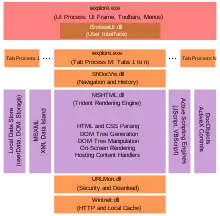
Internet Explorer 8 includes performance improvements across the HTML parser, CSS engine, mark-up tree manipulation as well as the JScript runtime and the associated garbage collector. Memory leaks due to inconsistent handling of circular references between JScript objects and DOM objects were corrected.[49] For better security and stability, IE8 uses the Loosely Coupled Internet Explorer (LCIE) architecture and runs the browser frame and tabs in separate processes. LCIE prevents glitches and hangs from bringing down the entire browser and leads to higher performance and scalability. Permissions for ActiveX controls have been made more flexible – instead of enabling or disabling them globally, they can now be allowed on a per-site basis.[50]
SmartScreen Filter
SmartScreen Filter extended Internet Explorer 7's phishing filter to include protection from socially engineered malware. Every website and download is checked against a local list of popular legitimate websites; if the site is not listed, the entire address is sent to Microsoft for further checks.[51] If it has been labeled as an impostor or harmful, Internet Explorer 8 will show a screen prompting that the site is reported harmful and shouldn't be visited. From there the user can either visit his or her homepage, visit the previous site, or continue to the unsafe page.[52] If a user attempts to download a file from a location reported harmful, then the download is cancelled. The effectiveness of SmartScreen filtering has been reported to be superior to socially engineered malware protection in other browsers.[53]
This feature can be disabled or enforced using Group Policy.
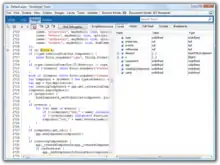
Suggested sites
This feature is described by Microsoft as a tool to suggest websites, which is done by the browser sending information to Microsoft over a secure connection, which keeps the information and a per-session, uniquely generated identifier for a short time.[54] The Suggested Sites feature is turned off by default and is disabled when the user is browsing with InPrivate enabled or visiting SSL-secured, intranet, IP address, or IDN address sites. Information that could be personally identifiable, such as the user's IP address and browser information is sent to Microsoft as an artifact of the HTTPS protocol. Microsoft has stated that they do not store this information.
The functionality was defended by Microsoft after itworld.com's Gregg Keizer described it as a "phone home" feature.[55]
Web Slices and authenticated feeds
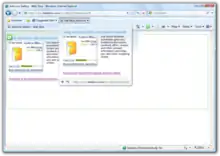
Web Slices are snippets of the entire page to which a user can subscribe.[36] Web Slices will be kept updated by the browser automatically, and can be viewed directly from the Favorites bar, complete with graphics and visuals. Developers can mark parts of the pages as Web Slices, using the hAtom and hSlice microformat. Web Slices have been compared to Active Desktop, introduced in Internet Explorer 4 in 1997.[56]
Microsoft donated the specification to the public domain under the Creative Commons Public Domain Dedication. It is also covered by the Microsoft Open Specification Promise.[57]
Windows RSS Platform also supports authenticated feeds beginning with Internet Explorer 8.[58]
Zooming and image scaling
Full-page zoom now reflows the text to remove the appearance of horizontal scrollbars on zooming.[50] Image scaling is done using bicubic interpolation resulting in smoother looking images when scaled.[59]
Using the compatibility mode will cause style issues with <select> form elements when changing zoom levels.
ActiveX behavior control
The information bar lets users allow an ActiveX control to run on all Web sites or only the current one. Users can easily make changes to this behavior through the Manage Add-ons dialog box. For each ActiveX control, there's a list of sites where it has been approved by the user.
Removed features
- It is no longer possible to have Internet Explorer automatically open the current session at the next startup. User should now do so manually.[60]
- Address Bar inline AutoComplete[38]
- CSS Expressions are no longer supported in Internet Explorer 8 Standards mode[61]
- Opening web folders (must now be done through the drive mapping tools).[62]
- Support for the proprietary <
wbr> element is dropped[63] - The option to delete files and settings stored by addons or ActiveX controls; rather, it is performed automatically.[64]
- Web page links and images can be dragged only to the desktop or to an open Explorer window.[65]
Standards support
Standards mode
Internet Explorer 8's main rendering mode, known as standards mode, has improved support for various web standards, especially CSS, compared to Internet Explorer 7 and earlier versions.[66]
The web standards supported by IE8 include the following:
- Accessible Rich Internet Applications (ARIA) specification for enhanced accessibility in Ajax-based rich Internet applications.[50]
- CSS level 1 is fully supported. CSS level 2 is mostly supported,[67] however several rendering bugs and regressions may affect conformance.[68] CSS level 3 is partially supported.
- Data: URIs (limited to non-navigable content less than 32KiB)
- DOM, which brings it in line with implementations in other browsers. Attributes and properties in DOM objects are now handled differently, and the behavior of the
getAttribute,setAttributeandremoveAttributemodifiers have been changed to match the behavior of other browsers.[37] - DOM storage
- HTML, including the HTML object fallback and the
abbrand elements[69] - Partial HTML 5 support, including cross-document messaging Archived 2010-07-29 at the Wayback Machine
- Selectors APIs
However, IE8 does not support some other W3C standards:
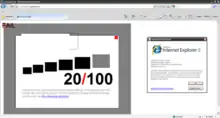
- MathML
- Significant parts of DOM Level 2 and 3, including the standard event model used by other browsers.
- Scalable Vector Graphics. The lack of SVG support in IE8 was criticized by world-wide-web inventor Tim Berners-Lee.[70]
- XHTML (except when used as a form of HTML)
IE8 passes the Acid2 test,[71][72] but fails the Acid3 test with a score of 20/100. During its development, Microsoft developed over 7,000 tests for CSS level 2 compliance, which were submitted to the W3C for inclusion in their test suite.[73]
Compatibility mode
Internet Explorer 8 was promoted by Microsoft as having stricter adherence to W3C described web standards than Internet Explorer 7. As a result, as in every IE version before it, some percentage of web pages coded to the behavior of the older versions would break in IE8. This would have been a repetition of the situation with IE7 which, while having fixed bugs from IE6, broke pages that used the IE6-specific hacks to work around its non-compliance. This was especially a problem for offline HTML documents, which may not be updatable (e.g. stored on a read-only medium, such as a CD-ROM or DVD-ROM).
To avoid this situation, IE8 implements a form of Version Targeting whereby a page could be authored to a specific version of a browser using the X-UA-Compatible declaration either as a meta element or in the HTTP headers.[74]
In order to maintain backwards compatibility, sites can opt-into IE7-like handling of content by inserting a specially created meta element into the web page that triggers the "Compatibility mode" in the browser, using:[66]
<meta http-equiv="X-UA-Compatible" content="IE=EmulateIE7" />
Adoption
| Internet Explorer Desktop Market Share | |
|---|---|
| — September 2022[75] via Net Applications[note 1][note 2] | |
| Internet Explorer 7 | 0.01% |
| Internet Explorer 8 | 0.04% |
| Internet Explorer 9 | 0.04% |
| Internet Explorer 10 | 0.02% |
| Internet Explorer 11 | 1.05% |
| All variants | 1.16% |
Microsoft Edge excluded from the list. | |
Five weeks after the release of IE 8 Beta 2 in August 2008, Beta 1's market share had grown from 0.05 percent to 0.61 percent, according to Net Applications. In July 2009, just under four months after the final release, the market share jumped to 13 percent.
As of September 2013, estimates of IE8's global market share ranged from 6.93% to 8.73%.[79][80][81]
According to Net Applications web analytics for October, 2014, Internet Explorer 8 accounts for 17.31% of web traffic, now overtaken by IE11 in usage.
Reviews and reception
In a March 19, 2009 review, Benny Har-Even of IT PRO offered some praise of Internet Explorer 8, noting its reliability and good features and concluding that it was "certainly the best version of Internet Explorer in a long time", but also that "there's not yet anything here to make Firefox users want to jump ship".[82] He offered praise to Microsoft for paying attention to their competition and producing "a better featured, faster and more reliable browsing experience for the masses" and suggested that as Microsoft continues to improve the product, it would become "harder to persuade the unconverted to switch away from IE."[82]
The next month, on April 2, Mark Joseph Edwards wrote in the newsletter Windows Secrets that the new edition of Internet Explorer had greatly improved security, speed and compatibility, but opined that it still lagged behind competitors in all three areas.[83] Edwards noted that at the time Internet Explorer 8 was still underperforming relative to other browsers in speed and was not as successful in displaying webpages as they were intended to display as such browsers as Firefox and Opera. In terms of security, he wrote that its "continued reliance on ActiveX makes the browser vulnerable in its very foundation."[83] For these reasons, he suggested that Firefox remained a better alternative to Internet Explorer 8, even though it was a "much better browser than IE 7."[83]
Around 2010, a theme named "BlueSky" was created for the Mozilla Firefox browser with the aim to resemble the graphical user interface of Internet Explorer 8 as accurately as possible.[84][85]
System requirements
IE8 requires at least:[1]
- Operating systems:
- Windows Server 2008
- Windows Vista
- Windows Server 2003 SP2
- Windows XP x64 Edition SP2
- Windows XP SP2 or SP3
- Processor speed: 233 MHz
- Memory:
- 64 MB on 32-bit versions of Windows XP or Windows Server 2003
- 128 MB on 64-bit versions of Windows XP or Windows Server 2003
- 512 MB on Windows Vista or Windows Server 2008
- Display: Super VGA (800×600) monitor with 256 colors
- Peripherals: Modem or internet connection; mouse or compatible pointing device
See also
- Comparison of web browsers
- Mandatory Integrity Control
References
- "Internet Explorer 8 system requirements". Microsoft. Retrieved 3 October 2012.
- "Internet Explorer 8 Upgrade Advisor does not function correctly after you install update 2183461 in Windows 7 or in Windows Server 2008 R2 (Revision: 2.0)". Microsoft Support. Microsoft. 4 November 2010. Retrieved 3 October 2012.
- Heiner, Dave (June 11, 2009). Meisner, Jeff (ed.). "Working To Fulfill Our Legal Obligations in Europe for Windows 7". Microsoft on the Issues. Microsoft.
- Mukherjee, Abhijeet (2010-11-08). "A Guide to Tab Groups in Internet Explorer 8". Guiding Tech. Retrieved 2 November 2021.
- LaMonica, Martin (May 3, 2007). "Microsoft Hints at General Plan for IE 8". CNET. CBS Interactive. Archived from the original on May 13, 2008. Retrieved March 1, 2008.
- Reimer, Jeremy (May 2, 2007). "Microsoft Drops Hints about Internet Explorer 8". Ars Technica. Condé Nast.
- Hall, Kevin (March 17, 2010). "Internet Explorer 9 Adds HTML5, Drops Windows XP". Dvice.com. NBCUniversal Media. Archived from the original on August 20, 2012. Retrieved August 5, 2010.
- Foley, Mary Jo (March 16, 2010). "Microsoft IE9 Developer Preview with HTML5 Support Ready for Download". ZDNet. CBS Interactive.
- Keizer, Gregg (11 March 2014). "US-CERT urges XP users to dump IE". Computerworld. IDG. Retrieved 6 April 2014.
- "Internet Explorer Support Announcement". Microsoft Support Lifecycle. Microsoft. 7 August 2015. Retrieved 18 August 2015.
- "2019-04 Cumulative Security Update for Internet Explorer 8 for POSReady 2009 for x86-based systems (KB4493435)". Microsoft Update Catalog. Retrieved 2021-07-07.
- LaMonica, Martin (March 20, 2006). "Gates Looks To Expand View Beyond Windows". CNET. CBS Interactive.
- Foley, Mary Jo (February 23, 2008). "Private IE 8 Beta 1 Test Build Coming Soon". ZDNet. CBS Interactive.
- http://www.microsoft.com/windows/products/winfamily/ie/ie8/readiness/Install.htm "Internet Explorer 8 Readiness Toolkit". Microsoft. Archived from the original on March 8, 2008. Retrieved March 5, 2008.
{{cite web}}: CS1 maint: bot: original URL status unknown (link) Internet Explorer 8 Readiness Toolkit - Thurrott, Paul (October 6, 2010). "Internet Explorer 8 Beta 1 Review". Supersite for Windows. Penton Media.
- "MSDN "What's New in Internet Explorer 8"". MSDN. Microsoft. Archived from the original on 2008-04-18. Retrieved 2008-03-06.
- "MSDN IE8 White Papers". Microsoft. Archived March 7, 2008, at the Wayback Machine
- http://www.microsoft.com/windows/internet-explorer/beta/worldwide-sites.aspx "Explore Windows 11 OS, Computers, Apps, & More | Microsoft". Microsoft. Archived from the original on August 28, 2008. Retrieved August 27, 2008.
{{cite web}}: CS1 maint: bot: original URL status unknown (link) IE8 Beta 2 download page. - Mediati, Nick (August 27, 2008). "Internet Explorer 8 Beta 2: Can It Outfox Firefox?". PC World. IDG.
- Sena Kannan, Vishwac (April 8, 2008). "IE8 Beta 1 For Developers Now Available in Chinese (Simplified) and German". IEBlog. Microsoft.
- Sena Kannan, Vishwac (September 17, 2008). "Internet Explorer 8 Beta 2 Now Available in 25 Languages". IEBlog. Microsoft.
- Foley, Mary Jo (December 10, 2008). "Microsoft releases to select testers updated IE 8 build". ZDNet. CBS Interactive.
- Hachamovitch, Dean (January 27, 2009). "Internet Explorer 8 Release Candidate Now Available". IEBlog. Microsoft.
- "Microsoft Announces Availability of Internet Explorer 8" Archived 2009-03-23 at the Wayback Machine
- Sena Kannan, Vishwac (April 25, 2009). "Internet Explorer 8 is now available in 18 additional languages". IEBlog. Microsoft.
- Sena Kannan, Vishwac (June 26, 2009). "IE8 Is Now Available on Windows XP for 5 More Languages". IEBlog. Microsoft.
- "Availability of Windows Internet Explorer 8". Support. Microsoft. 10 October 2011. Retrieved 15 November 2012.
- "Installing Internet Explorer 8". TechNet. Microsoft. Retrieved 15 November 2012.
- "Windows Internet Explorer 8 for Windows XP". Microsoft Download Center. Microsoft. 19 March 2009. Retrieved 15 November 2012.
- "Windows Internet Explorer 8 for Windows Server 2003 SP2 64-bit Edition or Windows XP Professional 64-bit Edition". Microsoft Download Center. Microsoft. 19 March 2009. Retrieved 15 November 2012.
- "Windows Internet Explorer 8 for Windows Server 2003". Microsoft Download Center. Microsoft. 11 March 2009. Retrieved 15 November 2012.
- "Windows Internet Explorer 8 for Windows Vista or Windows Server 2008". Microsoft Download Center. Microsoft. 11 March 2009. Retrieved 15 November 2012.
- "Windows Internet Explorer 8 for Windows Vista 64-bit Edition or Windows Server 2008 64-bit Edition". Microsoft Download Center. Microsoft. 19 March 2009. Retrieved 15 November 2012.
- Foley, Mary Jo (March 4, 2008). "IE 8 To Feature WebSlices, Activities". ZDNet. CBS Interactive.
- "Internet Explorer 8: Service Gallery". Microsoft. Archived from the original on September 6, 2008. Retrieved August 28, 2008.
- "New and Exciting Features". Microsoft. Retrieved March 5, 2008.
- "How Do I Make My Site 'Light Up' with Internet Explorer 8?". Microsoft. Retrieved March 5, 2008.
- "Address Bar improvements in Internet Explorer 8". Blogs.msdn.com. March 11, 2008. Retrieved January 25, 2013.
- "Internet Explorer 8 Readiness Toolkit". Microsoft. September 10, 2009.
- "Internet Explorer 8: Features (Section: Better Find on Page)". Internet Explorer 8 web site. Microsoft Corporation. Retrieved 8 January 2010.
Internet Explorer 8 includes a completely redesigned Find On Page toolbar, which is activated by pressing Ctrl-F or choosing Find On Page from the Edit menu or Search box drop-down.
- McDougall, Paul (August 26, 2008). "Internet Explorer 8 To Include 'Stealth' Privacy Mode". InformationWeek.
- "Microsoft Internet Explorer 8 To Include So-Called 'Porn Mode' Privacy Feature". Fox News. August 28, 2008. Retrieved September 13, 2008.
- "Porn Mode Comes to IE8". Indiatimes. August 20, 2008. Retrieved September 13, 2008.
- "'Porn Mode' for New Internet Explorer". metro.co.uk. August 28, 2008. Retrieved September 13, 2008.
- "Microsoft's 'Porn Mode' Browser". news.sky.com. August 29, 2008. Retrieved September 13, 2008.
- Peterkin, Tom (August 28, 2008). "Microsoft Launches 'Porn Browser' To Protect Privacy". The Daily Telegraph. Retrieved September 13, 2008.
- Tam, Pei Zuan (October 2, 2005). "Private Browsing with Safari Web Browser". MacNify.
- Keizer, Gregg (August 26, 2008). "Microsoft Adds Privacy Tools to IE8". Computerworld.
- "Circular Memory Leak Mitigation". Microsoft. Retrieved August 26, 2011.
- "How Do I Keep My Site and Add-Ons Working with Internet Explorer 8?". Microsoft. Retrieved March 5, 2008.
- "Please upgrade your browser - Microsoft Windows". Microsoft.com. Retrieved January 25, 2013.
- Lawrence, Eric (July 2, 2008). "IE8 Security Part III: SmartScreen Filter". Retrieved September 2, 2008.
- "The Q3 Socially Engineered Malware Test Report" (PDF). August 14, 2009. Archived from the original (PDF) on December 14, 2010.
- "Suggested Sites & Privacy". IEBlog. Microsoft. February 5, 2009. Retrieved February 6, 2009.
- "Microsoft Defends Internet Explorer 'Phone Home' Feature". ITWorld.
- Gralla, Preston. "IE8's New WebSlices Feature: Welcome to 1997". Computer World. Archived from the original on March 13, 2008. Retrieved March 12, 2008.
- "Web Slice Format Specification - Version 0.9". Msdn.microsoft.com. Retrieved January 25, 2013.
- "Authenticated Feeds" (PDF). Archived from the original (PDF) on March 9, 2013. Retrieved January 25, 2013.
- "Image Scaling in Internet Explorer 8". Msdn.microsoft.com. Retrieved January 25, 2013.
- "'Open These the Next Time I Use Internet Explorer' No Longer an Option in IE 8". Blogs.msdn.com. March 16, 2009. Retrieved January 25, 2013.
- Galineau, Sylvain (October 16, 2008). "Ending Expressions". Retrieved September 15, 2010.
- "'Open as Web Folder' Not in the Internet Explorer 8 File". MSDN. Microsoft. March 20, 2009. Retrieved April 4, 2009.
- ppgrainbow (March 19, 2008). "Internet Explorer 8 Available Now!". DeviantArt. Retrieved March 22, 2008.
- Windows Help and Support: "Delete webpage history"
- "4 Internet Explorer 8 Annoyances". ghacks.net. May 10, 2009.
- Hachamovitch, Dean (March 3, 2008). "Microsoft's Interoperability Principles and IE8". Archived from the original on August 30, 2008. Retrieved March 3, 2008.
- "W3C - CSS browsers". W3.org. Retrieved January 25, 2013.
- "James Hopkins » IE8 Bugs". Idreamincode.co.uk. Archived from the original on August 1, 2009. Retrieved January 25, 2013.
- "HTML Enhancements in Internet Explorer 8". Msdn.microsoft.com. October 26, 2012. Retrieved January 25, 2013.
- "Berners-Lee Unhappy with IE8". September 29, 2008. Archived from the original on October 15, 2008. Retrieved September 4, 2009.
- "IE 8: On the Path to Web Standards Compliance - ACID 2 Test Pass Complete". Microsoft. December 19, 2007. Retrieved December 20, 2007.
- Hachamovitch, Dean (December 19, 2007). "Internet Explorer 8 and Acid2: A Milestone". Retrieved September 15, 2010.
- Upton, James (March 26, 2009). "More Web Standards Tests Submitted to the W3C". Retrieved September 15, 2010.
- Gustafson, Aaron (January 21, 2008). "Beyond DOCTYPE: Web Standards, Forward Compatibility, and IE8". Retrieved March 22, 2007.
- "Browser Version Market Share". Net Applications. September 2022. Retrieved 2017-12-02.
- https://gs.statcounter.com/#desktop-browser_version-ww-monthly-202209-202209-bar
- "Global Web Stats". W3Counter. January 2011. Retrieved January 18, 2011.
- "StatCounter Global Stats". StatCounter. January 2011. Retrieved January 18, 2011.
- "Browser Version Market Share". Net Applications. January 2011. Retrieved January 18, 2011. Note: IE8 + "Compatibility Mode" numbers
- "IT PRO Reviews Internet Explorer 8".
- "Windows Secrets - No Reason To Rush Your Upgrade to IE 8".
- Dimmitt, Toby (4 January 2011). "60 Most Popular Firefox Themes". Design Press. Retrieved 17 January 2022.
[BlueSky] is the theme of the most perfectly simulating Internet Explorer 8 by far.
- "BlueSky :: Add-ons for Firefox". Archived from the original on 7 August 2011. Retrieved 17 January 2022.
{{cite web}}: CS1 maint: bot: original URL status unknown (link)